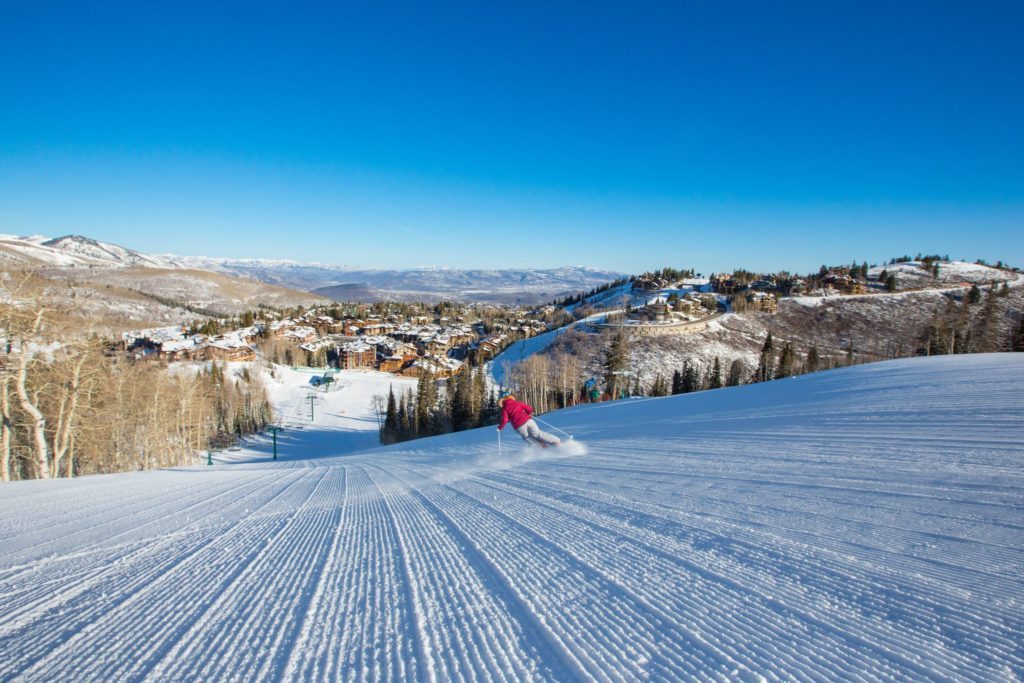World Cup Freestyle Mogul Runs are Made
World Cup Freestyle mogul runs are crafted, not born!
In my last blog, we discovered how mogul fields were naturally born. Today, we’ll turn to FIS Freestyle Ski World Cup Moguls that must be man-made to exact standards. Mogul competitions are deeply rooted into Deer Valley’s ski culture, as the resort has been hosting these events for the past 17 years, including of course, the 2002 Winter Olympics.

The first freestyle mogul competitions began in 1971 and the FIS Freestyle World Cup Circuit debuted in 1980. The first World Championships were held in 1986 in Tignes, France. Mogul skiing started as a demonstration sport at the 1988 Calgary Winter Olympics before becoming a medal event at the 1992 Albertville Winter Olympics.

I asked members of Deer Valley’s mountain venue operations team, to help us understand how Deer Valley creates the impressive freestyle mogul field on Champion ski run. To establish its consistent, regulation-profile, the steepest section of “Champion” had been precisely earth-graded prior to the 2002 Olympics.

The mountain venue operations team works with a number of outside contractors, volunteers and vendors, to get everything setup, running, to maintain the entire venue, and tearing it down when the competitions are over. It really takes a huge number of players with diverse talents to put up this classic event and produce the stunning show we’ve been enjoying for years.

To put the event together, the participants are as many as they are distinctively talented. It all begins with the resort’s snowmakers and groomers that are making sure there’s plenty of good snow at the venue. The resort’s snowmaking team starts by blowing all the extra snow needed onto the run. Then a snowcat, using a winch attachment, evens it out over the entire course. The hill is then snow-probed to make sure it’s sufficiently covered. If needed, extra snow will be made and spread around. The snowcat operators then shape the horizontal ridges that become bumps and will be finished into moguls by using hand-tools and skiing them into shape.

It’s obvious that weather conditions always plays a huge role in building the venue. Cold temperatures are always a plus. This ensures that the resort can make snow. Natural snowfall will have little effect unless it’s a huge storm that produces enormous quantities of natural snow on an already built course. The way Deer Valley Resort goes about building its own venue may differ from what other resorts hosting similar World Cup events might do, depending on the management team involved or the slope characteristics. However, the course must be built to satisfy the International Ski Federation (FIS) specifications.

Nothing is built randomly, the entire course is measured out to comply with FIS specs. Everything is spelled out, like course width, length, finish corral length, distances from the start line to the first jump and second jump to finish, jump sizes as well as bump width. Dual Mogul events require that four “zipper lines” be built (a zipper line is an alignment of moguls directly down the fall-line, over which skiers literally bounce off the top of every mogul in succession).

As you can imagine, creating this man-made mogul field is no small task. It takes about 10 days to build it from start to finish. Of course, it’s not just a matter of moving snow around or shaping bumps into ski moguls. The whole process also entails the interaction of the Ski Team officials including the FIS delegates, the Chief of Build, the Chief of Course, and all of the volunteers that will literally pitch-in in building and continuously maintaining the venue.

The snowcat operators are also critical in building the jump tables, the grades and in grooming the sidelines, as well as the TV camera platforms along the way. The Chief of Build and Chief of Course work together with the respective crews on jump construction and on mogul maintenance. The event crew is responsible for installing the safety fence and the protective pads while the resort’s own electricians are laying power and TV cables on the outer perimeter of the mogul course, so that projectors can be installed and oriented to light-up the venue.

In recent years, the official FIS specifications governing the course have remained pretty much unchanged, but like anything else, they’re always subject to change. Typically, mogul courses are between 650 and 885 feet long with an average slope grade of 26 degrees. The moguls themselves are set approximately 12 feet apart. The course includes two sets of small jumps that are used as take-off for aerial maneuvers consisting of upright or inverted tricks.

The Deer Valley course, Champion, has a length of 827 feet with a slope grade of 28 degrees, which is quite steep. Deer Valley’s Champion run is one of the steepest and longest mogul runs there is, making it a very challenging course. It is quite unique as it perfectly mixes the high intensity of skills international athletes bring to the event, with a crowd of 7,000 spectators cheering them on, under the lights!


 The Official Blog of Deer Valley Resort
The Official Blog of Deer Valley Resort



This website definitely has all of the information I wanted about this
subject and didn’t know who to ask.
Fascinating, thanks for preparing for the benefit of those interested, like me!
I’m watching the 2022 Olympics in China and the mogul course seems strewn with dark debris. I wonder if this is purposeful to give the competitors better visibility of the moguls?
Correct. It is pine that helps the athletes differentiate the sky from the ground. We use the same technique at Deer Valley during the world cup.